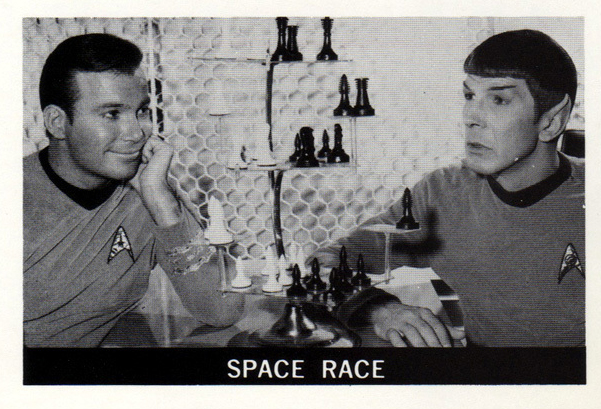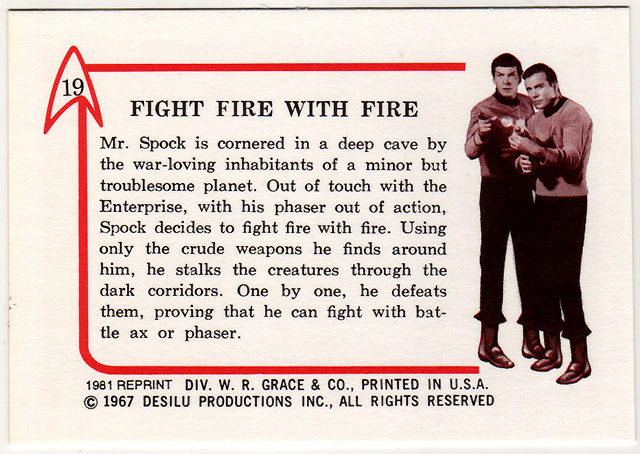1967 Leaf Star Trek Controversies!
By Kurt Kuersteiner ©2011 Monsterwax Trading Cards for The Wrapper Magazine
Space- the final frontier… Any boomer who likes science fiction knows that phrase is the introduction to Star Trek. Although the series was only an average success when it first aired in 1966 (and was cancelled in its third season), it garnered a giant cult following in reruns. This was not by accident. The series was produced by Desilu Productions, the same production company run by Lucille Ball (after her husband and comedy co-star Desi Arnaz resigned in 1962). Their big innovation in TV was recognizing that investing higher production values in their shows paid bigger dividends in reruns. Many of their other productions (like The Untouchables, I Love Lucy, The Andy Griffith Show, and Mission: Impossible) made big money in reruns and further proved the point.
One thing they did not predict, however, was the tremendous amount of money Star Trek would generate in licensing. (It is difficult to imagine a series from that decade that has been licensed more.) Books, comics, lunch boxes, computer games, costumes, and of course, trading cards. Of all the numerous Star Trek trading cards sets that have been published, none of them are as expensive, controversial, or mysterious as the very first one: The 1967 Leaf set.
Licensing is often cited as the reason the Leaf set was soon withdrawn from the market, causing it to be so scarce today. But what kind of licensing issue caused the problem? Trading-Cards.org states, "(Leaf) printed the cards before they were granted the final license to do so – and, as it turned out, they didn't get the license." However, no source for this claim is provided and it is probably just a theory.
Another possible cause was disagreement over who had the rights to sell the license. The cards themselves credit Desilu Productions with the copyright, but did the actors give their consent to sell their publicity photos for a card license without getting a cut? Or did the writers agree to let their plots get summarized and sold for gum cards without earning a royalty? Your guess is as good as mine, but I suspect it was NOT because the company printed the cards before it had the license. I think it was because either the actors or the writers kicked up a fuss once the cards appeared… or maybe both!
William Shatner has been accused of many things, but he has never been called timid when it comes to getting money from memorabilia. (I heard one outraged fan claim Shatner wanted $100 to sign something. But you never know: He may have pestered the actor during lunch!)
I personally believe it was the text. If you read the Leaf episode synopsis, you are struck by how totally off they usually are from the episodes they purport to describe. In most cases, it's as if the writer went out of his way to get it wrong. And that's exactly what they were supposed to do. (Otherwise, the show writers could claim they were having their ideas exploited beyond the terms of their contract without getting paid more.) You see, that's what I think caused the problem, because in several cards, enough of the actual plot devices are present to give a writer a claim they were ripped off.
Take for example, card #3: A Grup Appears. "Mr. Spock and Captain Kirk meet a Grup on a planet, a duplicate of Earth which sent out a stellar S.O.S. Only children inhabit it. When they become adults or Grups, they go berserk and die—result of a strange attempt to prolong life. The Enterprise crew contract the experimental illness and are doomed until Dr. McCoy, fighting the deadly deadline finds a cure." That's basically the accurate plot of the TV episode, Miri.
There are plenty of other examples, including #5 Murasaki Mischief, which correctly describes the plot of The Galileo 7. In that episode, a shuttle is stranded on a planet and attacked by giants until Spock drains the landing party's phasers to refuel the craft and escape.
There are numerous other examples as well: #9, Horta Emerging, accurately describes the plot to Devil In The Dark, along with the corresponding photo.
Meanwhile, other TV episodes like What Are Little Girls Made Of?, are completely rewritten beyond recognition, as it is in card #32, The Earth Killer. This was an episode starring Ted Cassidy (aka, Lurch from The Addams Family) as Ruk, a hulking android. To rewrite that episode is rather odd, because it was faithfully recreated in 55 card detail in the Topps AB&C Star Trek series just two years later (for UK collectors).
But the cause of the licensing problem is only one of two big controversies regarding the Leaf series. The other issue is the so-called "European version" of the set. In the mid 1990s, a dealer claimed to have discovered a warehouse find of what he said was a "rare European edition of the series that were never released and were now available for sale." This "authentic 1967" (albeit European) series showed up in The Wrapper for sale for $50 or so. I wanted to check it out for myself, so I bought one. I was not impressed. They looked too new, and I noticed moray patterns on the photos. That seemed to suggest fraud, because moray patterns occur when photos of screened images (like cards) are made. Photos also have dots (or grains), but not a pattern like screened images do. When a photo is screened for printing, it's broken down into unified dots per inch (d.p.i). Although the size of the dots change (creating a print image), the number of dots per inch do not. (That's what causes a pattern when it is rescreened and reprinted.) If the European company were really licensed to make the cards, they would have been sent the film (like Topps did with their AB&C partner in the UK), not a set of cards to rescreen and make fuzzy and crappy copies. So it just didn't make sense. Other collectors must have had similar thoughts, because a debate broke out about the authenticity of the cards in The Wrapper and Non Sports Update magazine.
By this time, however, the dealer had produced a letter from Paramount (the folks who bought the series from Desilu) stating the cards were authentic and giving their blessing to sell them. This letter had the effect of shutting up most the critics, and letting the dealer continue to sell his big "find". All the diehard critics (guilty as charged!) could do was grumble. The other side had prevailed, but it still seemed fishy… It's rather reminiscent of the recent "Birther" debate, isn't it? Suspicions arise, conspiracy theories form, allegations are made, a divisive public debate follows, and finally, a document is produced that shames the critics into silence (except the blowhards who won't let it go). But unlike the political controversy, its card counterpart didn't end with a return to the status quo. For the revealing sequel to this debate, one can read Lynne Stewart's 2010 update about the cards from Amok Times (one of the most established Star Trek newsletters). In it, she states:
"I was recently approached by Richard Arnold, who while working closely with Gene Roddenberry in the merchandising division for many [years], had a front seat for the Euro set 'find'. Dan Kremmar and his wife approached him in the mid-90's with the cards he reported to have found in a warehouse. According to him, these are also from 1967, but were never released in the European market as planned.
"According to Richard, 'He sent me a sample set to examine, which he told me I could keep, saying they were worth something like $1500 to $2000. I immediately shot off a letter to him, on my Star Trek stationery, telling him that the cards were NOT an heretofore unknown version of the original set, but were in fact a modern reprint, and not one that had been authorized by the studio (I worked closely with Paramount's Merchandising and Licensing Division at the time). There was no doubt in my mind that someone was trying to pass these off as originals, when they so obviously weren't (I had a couple of original sets myself). A few weeks later I got a call from someone in the M & L offices, asking me where I got off writing a letter of authenticity for Dan and his wife. I asked what they were talking about, and went over to their offices to see. Sure enough, Dan had taken my letterhead, my signature and some of the wording of my original letter to him and had fabricated a letter of authenticity from me, stating that his cards were, indeed, a rare, heretofore unknown European edition of the 1967 Leaf cards! It was Dan and his wife who were printing up the cards (it turned out that her family in Holland owned a printing company), and that they were hoping to enrich themselves passing these sets off as real and selling them for a bundle. Paramount's attorneys then sent him a Cease and Desist and demanded that he immediately stop printing up any more sets, and to get rid of the sets that they'd already printed, but that it had to be made clear that these were reprints and not original 1960s sets. Dan continued to dance around the edge of legality and eventually he and his wife moved back to Holland to get away from Paramount's lawyers.'"
So it may have taken over a decade for the truth to get out, but the fraud was finally exposed. Maybe now people will stop repeating the myth of the "European Version" and start calling it what it was: an unauthorized European reprint (or hoax). Keep in mind, there was also an earlier reprint of the Leaf series, but that one has a 1981 copyright that states it's a reprint. The European hoax does not.
Fortunately, there are several ways to detect the reprints, and the most foolproof method doesn't require any experience or side by side comparing. Just flip the card 90 degrees and examine the edge with a magnifying glass. The originals used a glossy white stock that has gray cardboard sandwiched between the two white surfaces. All the reprints, however, used solid white stock. If the cut edge of the card appears solid white, it's a fake.
So there you have it, the history of controversies regarding Leaf Star Trek. The verdict is still out on the question of why it was first withdrawn, but at least we know the story behind the European hoax. Let's hope the future provides more answers, and less fake "finds".
[Design of reverse. This one states "reprint", but the so-called "European version" does not. However, looking at the edge of the card (for the gray sandwiched paper) will reveal if it is vintage or not.]
rev. 8/15/11 Issue #261

